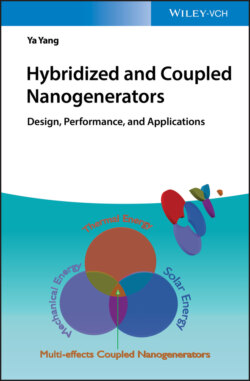Читать книгу Hybridized and Coupled Nanogenerators - Ya Yang - Страница 17
1.3.2 Multi‐effects Coupled Nanogenerators
ОглавлениеMulti‐effects coupled nanogenerators are focused on multifunctional materials such as ferroelectric materials. As illustrated in Figure 1.8, Prof. Ya Yang and coworkers invented the coupled nanogenerators in 2015 [9], representing a new research field in scavenging multiple energies in the environment. By utilizing the piezo–tribo–pyro–photoelectric effects, the multi‐effects coupled nanogenerator with one structure and one material can be used to scavenge various energies at the same time. The core of multi‐effects coupled nanogenerator is the multifunctional material, where the first material that was used for the coupled nanogenerator is the ferroelectric PbZrxTi1‐xO3 (PZT) material [9]. As depicted in Figure 1.9a, the coupled nanogenerator consists of a PZT material, a polyamide material, and two electrodes, where the PZT material has the piezoelectric, pyroelectric, and photovoltaic effects as the active material. The polyamide film as the triboelectric material was utilized to generate the triboelectric current/voltage signals. The top electrode consists of the ITO film together with Ag nanowires–polydimethylsiloxane film. Figure 1.9b presents the produced charge amounts in the different parts of the coupled nanogenerators. Owing to the pyroelectric effect, the produced charge amount is about 0.39 μC. The produced charge amount is about 1.37 μC due to the photovoltaic effect and that due to piezoelectric and triboelectric effects is about 5.91 μC. When the different energies are applied on the device, the produced charge amount can be up to 7.06 μC, which is much larger than that of individual energy scavenging methods.
Figure 1.7 Working principle of pyroelectric and photovoltaic coupled nanogenerators. (a) Schematic diagram of the mechanism of pyroelectric effect. (b) Schematic diagram of the mechanism of photovoltaic effect. (c) Schematic diagram of the mechanism of pyroelectric and photovoltaic coupled effect.
Source: Reproduced with permission from Ma et al. [46]. Copyright 2017, John Wiley and Sons.
Figure 1.8 Illustration of multi‐effects coupled nanogenerator toward multi‐energies scavenging.
Source: Reproduced with permission from Zhang et al. [9]. Copyright 2017, John Wiley and Sons.
Figure 1.9 One‐structure‐based multi‐effects coupled nanogenerator. (a) Schematic diagram of the designed one‐structure‐based multi‐effects coupled nanogenerator. (b) Transferred charges of the different devices.
Source: Reproduced with permission from Zhang et al. [9]. Copyright 2017, John Wiley and Sons.
The ferroelectric PZT material is toxic due to the presence of Pb. It is necessary to look for other high‐performance ferroelectric materials without Pb for the coupled nanogenerators. It has been reported that a polyvinylidene fluoride (PVDF)‐based one‐structure‐based coupled nanogenerator has been utilized to scavenge mechanical and thermal energies at the same time by using tribo–piezo–pyroelectric effects [47]. By charging a capacitor, the coupled nanogenerators have the best charging performance. However, the piezoelectric constant of the PVDF is too small with about 20 pC/N. Ji et al. reported a ferroelectric BTO material‐based multi‐effects coupled nanogenerator [48], where the piezoelectric constant of BTO can be larger than 300 pC/N. On comparing the charging curves of the different conditions, it is seen that the coupled nanogenerator exhibited faster charging performance than the other individual effects.
As compared with the other hybridized nanogenerators with simple physical integrations, the one‐structure‐based multi‐effects coupled nanogenerators have more advantages such as simpler structure, smaller volume, and lower cost, representing a new research trend in multifunctional materials‐based all‐in‐one multiple energy harvesting in our living environment. Moreover, these coupled nanogenerators have potential applications in multifunctional sensor systems. Owing to the multifunctionalities achieved by one material, these new sensor systems exhibit more advantages than the conventional methods such as higher resolution, smaller device size, and so on. Obtaining high‐performance multifunctional material is still a challenge, and more research work is needed along this research direction.
